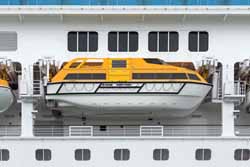Improving maritime emergency response
The 'Ship evacuation data and scenarios' (SAFEGUARD)(opens in new window) project was established to provide full-scale data for calibration and validation of ship-based evacuation models. It also worked to propose and investigate additional benchmark scenarios to be used for certification analysis. A lack of real-life data on how people behave in a maritime emergency makes it difficult to assess the accuracy and reliability of evacuation simulation software and tools aimed at safeguarding passengers and crew. The SAFEGUARD team built on developments in earlier research projects, and also on revisions of the International Maritime Organization (IMO) protocol for passenger ship analysis and certification. They performed five full-scale passenger trials on three different vessels (two Ropax (passenger and cargo) ferries and one cruise ship). Research work included the quantitative study of accident databases and the qualitative assessment of accident reports and feedback from professional mariners. Researchers studied accident reports and testimonies, obtaining important information on past incidents. The team also reviewed procedural aspects: their investigations highlighted differences between Ropax and cruise ships in evacuation processes, and their impacts. SAFEGUARD made extensive and thorough use of maritime evacuation software to test the proposed enhanced scenarios and the effects of newly compiled response-time distributions. The project team built evacuation models of the ships using each of the three tools used for software testing: EVI (Safety at Sea), maritimeExodus (FSEG) and ODIGO (Principia). These helped to define the evacuation scenarios and run the simulations. The project results, which succeeded in achieving all set objectives, were presented to the IMO in three information papers. They included recommendations for future revisions of regulations on evacuation analysis: five response-time data sets and two validation data sets. SAFEGUARD developed a validation protocol, together with acceptance criteria for evaluating maritime evacuation simulation tools. Finally, the project also evolved a set of enhanced certification scenarios. Information regarding human performance in full-scale ship trials is imperative for the validation and calibration of ship-based evacuation models. The SAFEGUARD project has contributed to this critical feature of efforts directed at enhancing safety at sea.



